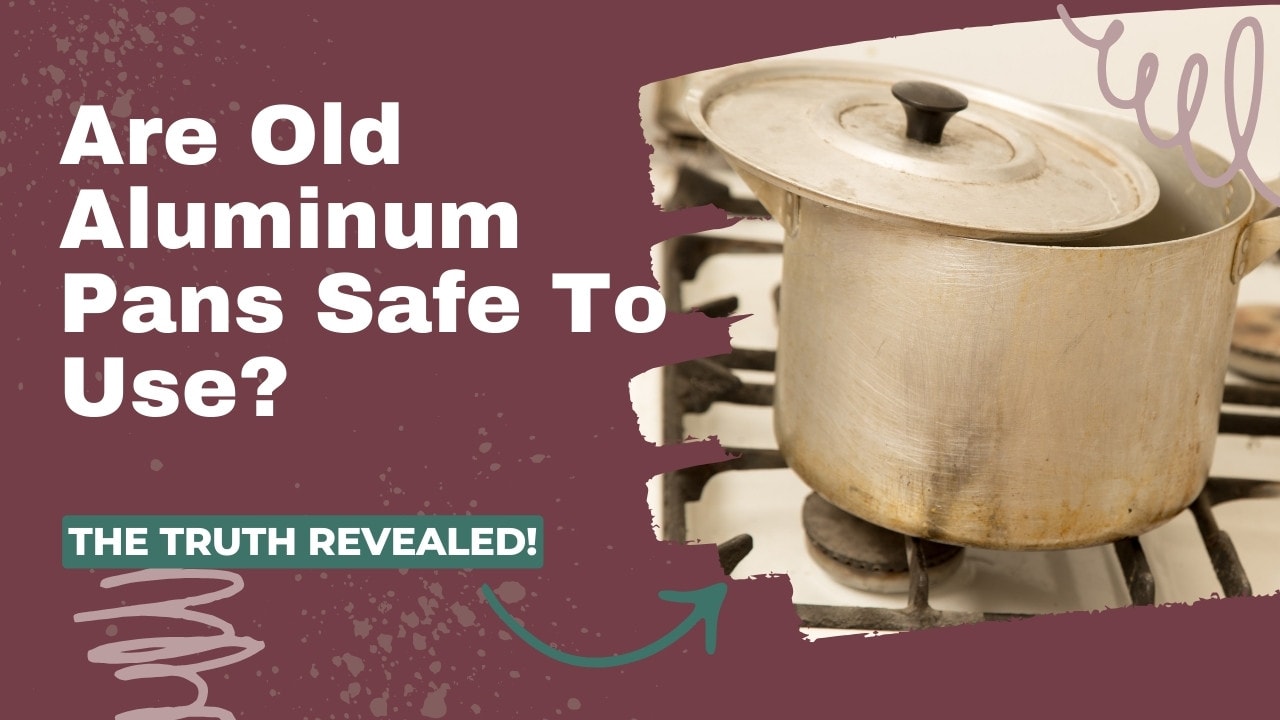DISCLAIMER: THIS PAGE DOES NOT PROVIDE MEDICAL ADVICE.
This page is intended for informational purposes only. No material on this page is intended to be a substitute for professional medical advice, diagnosis, or treatment. Always seek the advice of your physician or other qualified healthcare provider before changing your dietary or cooking habits.
Have you received your mother’s set of vintage aluminum pans but don’t know whether it’s safe to use? You have every right to be concerned, given all the controversies over aluminum and aluminum cookware. Are old or vintage aluminum pans any better or worse than current ones?
Are Old Aluminum Pans Safe to Use?
Not all old aluminum pans are safe to use. Cooking in uncoated aluminum can transfer aluminum to your food – which could be a health concern. You should also consider the pan’s age and place of origin, its history of use, its condition, and its coating or seasoning to make an informed decision about whether or not to use it.
How Do You Tell if It’s Okay?
Want to determine if your grandma’s vintage aluminum pan is safe? Ask yourself these questions first.
Is It Coated?
To start, determine whether or not your old aluminum pan is coated or bare.
If your pan is coated, determine the type of coating. Some aluminum pans are coated with Teflon or ceramic nonstick. (In fact, most Teflon nonstick or ceramic nonstick pots and pans have an aluminum core.) Others may be coated with enamel.
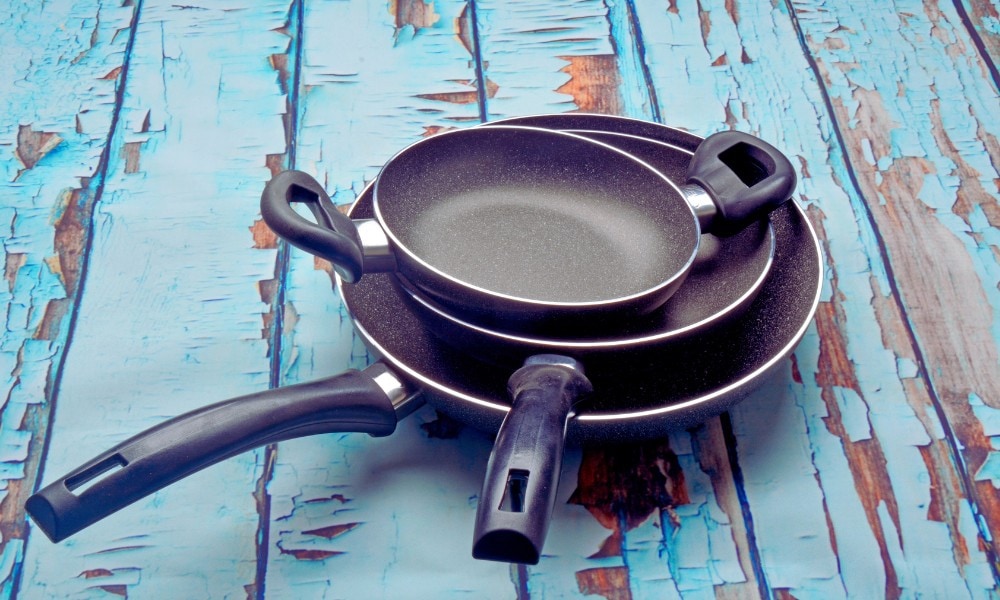
Teflon Nonstick Coatings
If your aluminum pan has a Teflon coating, you should try to figure out when it was made. In 2015, the EPA banned the use of a chemical called PFOA, which had previously been used in Teflon coatings.
PFOA is a “forever chemical” (PFAS) that doesn’t break down in nature. Exposure to PFOA (which happens mainly through drinking water) can contribute to several health problems, including cancers, according to the Minnesota Department of Health.
However, according to WebMD, cooking in Teflon cookware that contains PFOA poses “little or no harm to your health.”
All that to say: Teflon cookware made before 2015 has a high chance of containing PFOA. (There is debate as to whether the chemicals that replaced PFOA in Teflon are actually safer than PFOA, but that’s a different conversation.)
Enamel Coatings
Enameled aluminum pans have coatings made of powdered glass fused onto the metal. Enamel is generally considered safe due to the FDA’s strict regulations. However, vintage enameled cookware could contain dangerous heavy metals.
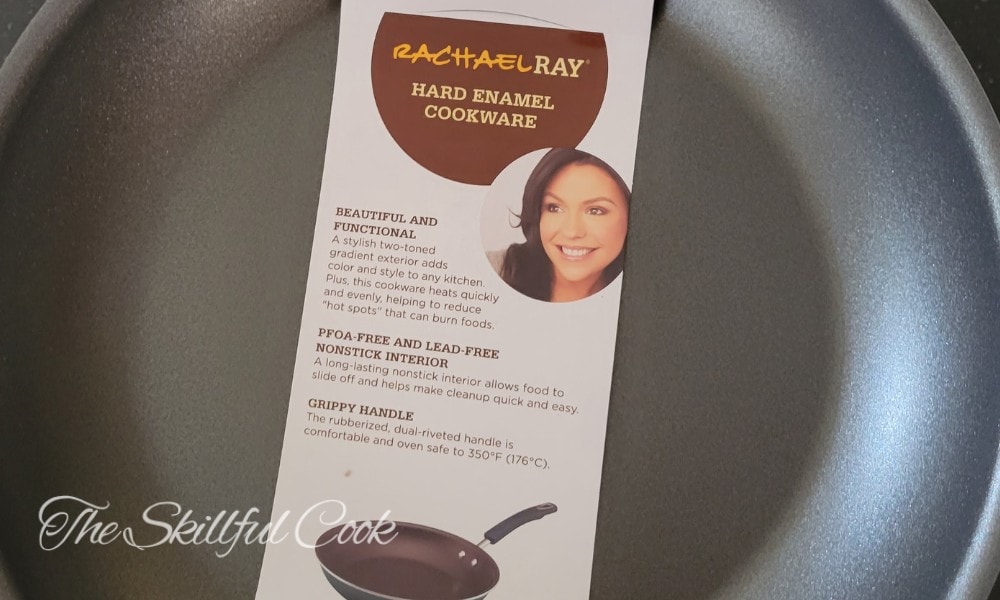
Lead and cadmium were historically used to give yellow, orange, and red enamel a bright color. While restrictions on lead in paint tightened in the 1970s, it may be impossible to know if your enameled pan is safe or not without leach testing it and sending results to a lab.
Is It Hard Anodized Aluminum?
Some aluminum cookware has been anodized. Anodization is an electrochemical process that oxidizes the outer layer of the metal. This layer is hard and non-reactive, making cookware strong and corrosion-resistant. It eliminates aluminum’s biggest drawbacks: its softness and reactiveness. So, hard anodized aluminum pans are generally safer than raw, uncoated aluminum.
If you have a vintage aluminum pan and don’t know if it’s anodized, there’s a telling sign that helps you decide. Most anodized aluminum cookware has a dark color because the anodization process turns the silver metal into black. It may also be gold or bronze, depending on the anodization process. The color isn’t applied as a coating. Instead, it’s integrated into the metal. It has a matte finish and doesn’t look shiny.
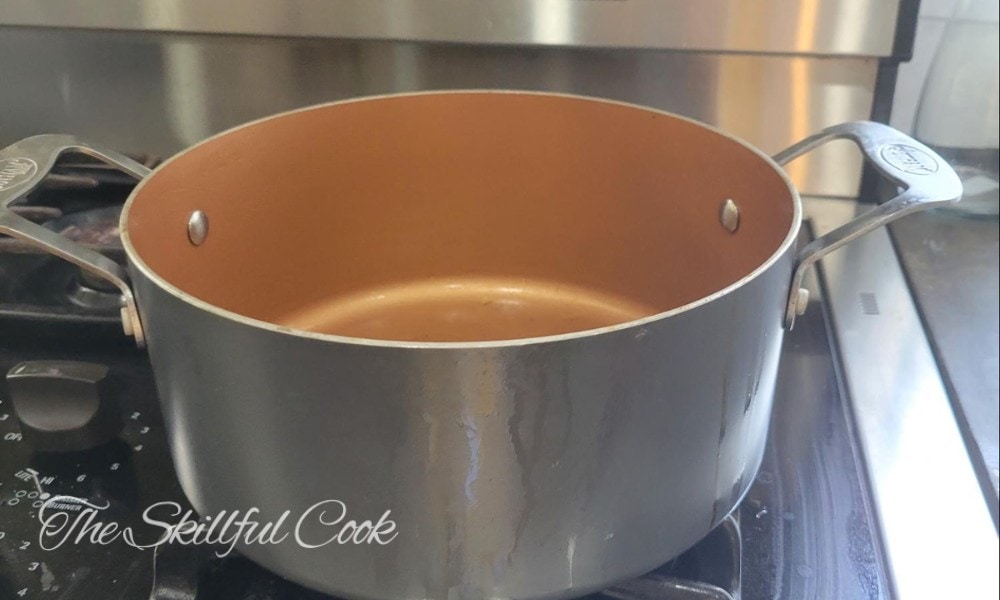
You could also test the pan’s surface by gently scratching it. If it scratches easily, it’s not anodized.
But the most surefire way is the conductivity test. If you can find an ohmmeter, use it to check the metal’s conductivity. Anodized aluminum is much less conductive than raw aluminum. Check your reading against these numbers. If it’s much lower, your pan is anodized.
Is Natural/Raw Aluminum Cookware Safe?
If you’ve determined that your vintage aluminum pan is made of raw aluminum without any coatings, is it safe to cook in? Or should you throw it away?
Well, it depends on your stance regarding aluminum consumption and whether or not it poses health risks.
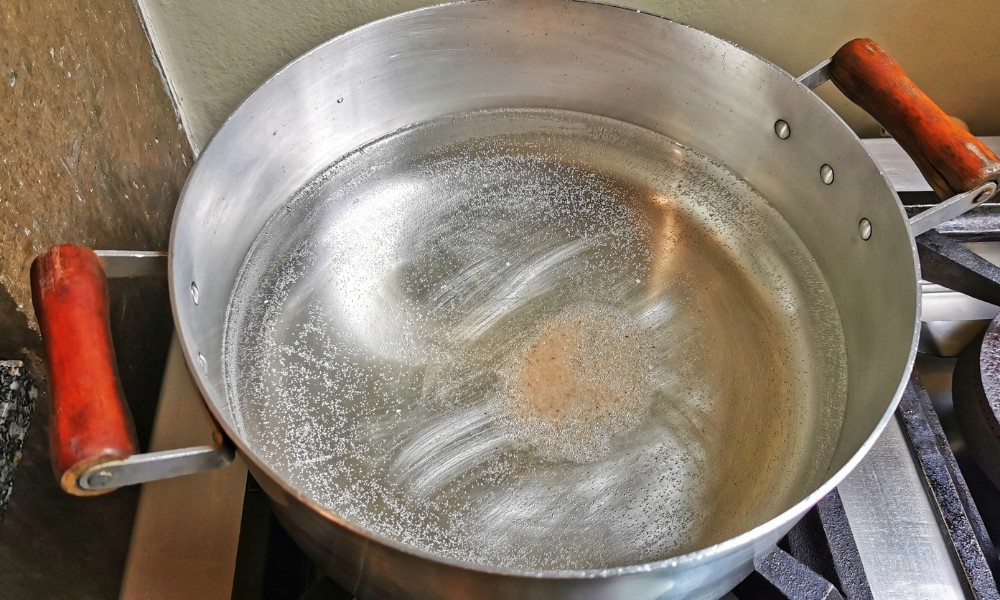
It has been demonstrated that cooking with aluminum transfers aluminum to food. At least one study links this increase in aluminum consumption to increased oxidative stress markers. Aluminum in high doses can lead to oxidative stress and brain, kidney, or liver damage.
However, the CDC’s Agency for Toxic Substances and Disease Registry (ATSDR) classifies aluminum cookware as “not considered to be harmful” because the amount of aluminum absorbed when cooking in aluminum pans is minimal compared to exposure from other sources.
The truth is that aluminum is all around us: in our air, water, and soil. It finds its way into our body in many ways besides migrating into our food from cookware.
According to the CDC, our body excretes over 95% of ingested aluminum, only absorbing 0.01%-5% of aluminum from food.
It is wise to be conscious of your overall aluminum exposure. However, you may ingest more aluminum from drugs like antacids than from cookware.
Is It Cast, Forged, or Stamped?
Consider how the pan was formed. Casting involves melting the metal and pouring it into die casts. Stamping is a cold process that involves using aluminum sheets and putting them under pressure to give them the desired shape. Cast aluminum may have a more porous and less uniform surface. Die-cast cookware has integrated handles, as the handle is also a part of the mold. Forged aluminum pans are thick and heavy, made from ingots rather than aluminum sheets.
Cast, stamped, and forged aluminum pans do not have significant safety differences between them. Any of them, if not anodized, can be reactive and leach aluminum into your food. Stamped aluminum, since it’s cheaper than cast or forged aluminum, is less likely to be hard anodized – but there are always exceptions.
Where Was It Made?
If your aluminum cookware was made in a modern factory, it may not matter where it was made. However, if your aluminum pan was handmade in a developing country, you may want to look deeper into its origin.
Studies have found that some aluminum cooking pots made in developing countries contain lead. Oftentimes these were made from recycled or salvaged aluminum alloyed with lead.
When Was It Made?
The aluminum used in modern alloys is free of heavy metals like lead and cadmium. However, lead was historically used in some commercial aluminum alloys to improve machinability.
Today in the US, FDA regulations and California Proposition 65 regulate the use of lead in consumer products. The use of lead in cookware was banned in 1978.
California Proposition 65, passed in 1986, requires manufacturers to declare potentially hazardous chemicals or materials found in their products.
If you believe that your vintage pans were made before 1978, or were artisan-made and not commercially tested at the time of manufacture, you may want to have them tested for heavy metals before using them.
A 2023 letter from the FDA outlines methods to test lead contamination in cookware. The test involves boiling vinegar in the cookware for two hours and letting it rest for 24 hours. Then, the lead levels are measured and should be reported. This test should be done by a respected lab.
Home tests using lead swabs and XRF (x-ray fluorescence) devices may not be reliable methods for determining whether or not your vintage aluminum cookware contains lead. If you want to be 100% sure that your old aluminum cookware is safe, have it leach-tested at a lab.
Is It Seasoned?
Is your vintage aluminum pan seasoned? If so, it’s more likely safe to use. Seasoning is formed by layers of polymerized oils bonded to the metal. This coat doesn’t come off easily and makes aluminum less reactive. It also makes a pan nonstick. The more you cook with oil in your aluminum pan, the thicker the seasoning will get.
Don’t mistake seasoned aluminum for hard anodized aluminum. Both processes form a dark coating on aluminum pans, but seasoned aluminum can become nearly black.
Seasoning aluminum cookware is no different than seasoning cast iron or carbon steel. Here’s how to do it:
- Wash the pan thoroughly and scrub any food residue or burned oil stains.
- Put the pan on the stove and heat it until it dries completely.
- Grab some cooking oil with a high smoke point and rub it into the pan using a paper towel. Clean excess oil and ensure there’s a thin layer on the surface.
- Put the pan in a preheated oven at 400°F – 450°F for 30 minutes to one hour.
- Repeat seasoning if needed. Or simply cook with your pan as much as you can until a thick seasoning layer is formed.
Is it Warped or Dented?
Aluminum is a soft metal, and non-anodized aluminum cookware is prone to warping. Warped or dented pans can be a safety hazard since they don’t sit firmly on a flat stovetop. Warped or dented pans can spin or slide off the stove and burn you if filled with hot water or food.
Aluminum handles can also get hot, especially if you have a cast aluminum pan with integrated handles. You can avoid accidents and burns by using pot holders while handling these pans.
Oxidized Aluminum Pots and Pans
Boiling water in an aluminum pan could cause it to turn dark or blotchy. This discoloration is the result of aluminum oxidation. Although it makes your cookware unattractive and takes away the original shiny finish, it’s not toxic or dangerous.
On the contrary, it can form a protective layer that reduces leaching and the metallic taste that aluminum can give to food.
But, if you want to restore oxidized aluminum, there’s an easy method. You only need some solid soap (not dish soap) and steel wool. Rub the steel wool on the soap and give your pan a good scrub until it gets shiny again. You may want to wash it with a sponge and regular dish soap after scrubbing to give it a complete cleanup.
If you don’t like to scrub your pan, you can try the methods recommended in the video below.
If your old aluminum pans are deeply pitted, they will be much more difficult to restore.
Is It Safe to Eat Black Residue from Aluminum Pans?
The black residue from aluminum pans is an oxidized layer formed after boiling water. It is not toxic in small amounts, but I would avoid eating it. Very old or pitted aluminum pans are more likely to leach aluminum into your food than pans with a protective layer of oxidation or seasoning.
Conclusion
Old aluminum pans may be unsafe to use if imported from developing countries or made by unknown manufacturers. Try to determine when and where the pan was made and if it is made of natural, raw, coated, anodized, or seasoned aluminum. Lead was not banned in cookware until 1978, so pots and pans made before that date, even in the US, may be unsafe. The best way to know whether or not your aluminum pan is safe to use is to have it leach tested at a reputable lab.

